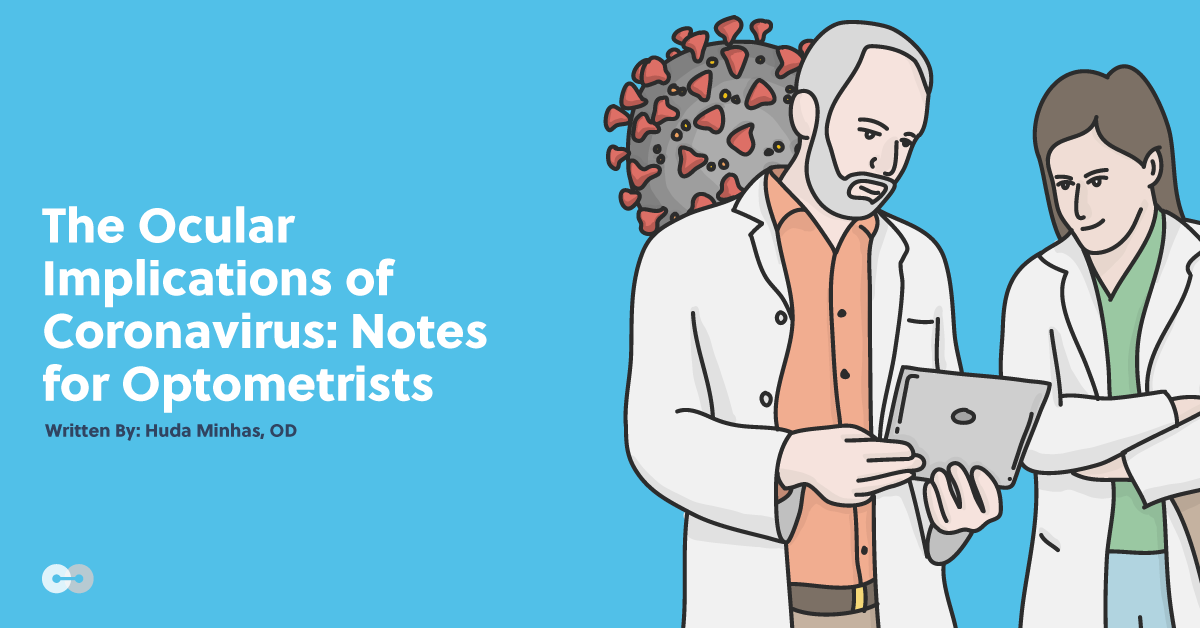Coronavirus disease (COVID-19) is a worldwide pandemic that has reached almost every country. It is a single stranded RNA virus that belongs to the family Coronaviridae. We have experienced waves of this family of viruses in the past: severe acute respiratory syndrome-coronavirus (SARS-CoV) in 2003, and Middle-East respiratory syndrome-coronavirus (MERS-CoV) in 2012. These viruses can infect a wide range of hosts and cross species barriers, with illnesses ranging in severity from the common cold to more severe outcomes such as what was seen with MERS and SARS.
Scientists are working tirelessly to gather new information about this strain of virus. This article highlights current research, especially in relation to its ocular effects. Optometrists
currently treating urgent and emergent cases in their practices should pay particular attention to these effects and to the official recommendations for healthcare practitioners from the CDC and WHO.
Epidemiology
The number of coronavirus cases around the world is constantly changing.
Johns Hopkins gives a near-real-time estimate of the current situation across the globe. As of 8:44am PT on April 6, 2020, there have been a total of 1,292,564 cases worldwide. Among those, approximately 21% have recovered, with 5.4% reported deaths. According to
Worldometers, of those currently infected, 95% have a mild case, with 5% under serious/critical condition. Individuals with the highest risk are those over 60, with pre-existing comorbidities (in order of cardiovascular disease, diabetes, chronic respiratory disease, hypertension, and cancer). The fatality rate by sex seems to be higher for males (4.7%) vs females (2.8%), but some
think that number may be inflated due to increased prevalence of smoking in men in China.
Conjunctivitis
On February 28th, 2020, the New England Journal of Medicine published a large
study on the clinical characteristics of coronavirus disease. It found that out of 1099 patients, 0.8% (9 patients) had conjunctival congestion.
The latest
update from the American Academy of Ophthalmology (AOA) suggests that the virus can sometimes cause a follicular conjunctivitis similar to other viral types. A
case report from Columbus, OH highlighted a woman in her 60s who exhibited all the tell-tale signs of COVID-19 (fever, productive cough, travel history in hotspots) along with purulent discharge. Her doctors prescribed her oxygen supportive therapy, as well as gentamicin and levofloxacin eye drops, which resolved her symptoms almost completely within a few days.
There are many strains of viruses that cause ‘pink eye,’ and most of them occur seasonally in the winter. Overall, this severity of viral conjunctivitis is rare. There are reports circulating in the media that highlight red, itchy eyes as an early sign. However, we have also crossed into the spring equinox, which means pollen is in abundance. There will generally be a rise in allergic conjunctivitis, with a key symptom of itching. Depending on the case history, many times supportive therapy with cool compresses, artificial tears, and time will resolve most cases of viral conjunctivitis.
A few recommendations to patients include:
- avoid rubbing the eyes
- wear sunglasses as a protectant against respiratory droplets
- switch to glasses instead of contact lenses
Does it spread through aqueous tears?
SARS-CoV-2 has been known to be spread through droplets, but
a new study coming out of Singapore suggests that viral shedding through tears is unlikely. Seventeen COVID-19 patients were monitored from initial symptoms to recovery at various intervals via nasopharyngeal and tear swabs. None of them exhibited ocular symptoms except for one who developed conjunctival injection and chemosis during their hospital stay. The virus was not detected in any of the tear samples.
Another study was conducted in China, with thirty participants with SARS-CoV-2 with pneumonia (among which 9 were severe). The study only had one participant with conjunctivitis whose swab was positive (collected in the early stage). All other patients showed negative results. The patient with conjunctivitis was categorized as viral with conjunctival congestion and aqueous secretion. This patient did not have other symptoms (severe fever, respiratory issues) when the sample was collected. This study emphasized that routine disinfection of instruments can help prevent spread of the disease, but recommends that optometrists/ophthalmologists wear goggles as a necessary protective measure.
Both studies have limitations with sample size and participants with conjunctivitis.
Conclusion
Let’s continue to take necessary precautions with disinfection of lanes and equipment, along with making sure we wear protective gear to prevent the spread of this virus. New reports will continue to surface with findings, and hopefully we at CovalentCareers can help to
keep you updated.
CovalentCareers is committed to supporting optometrists and optometry students during the Coronavirus pandemic. For more optometry-specific resources and information, visit our Optometry COVID-19 Resource Center.
